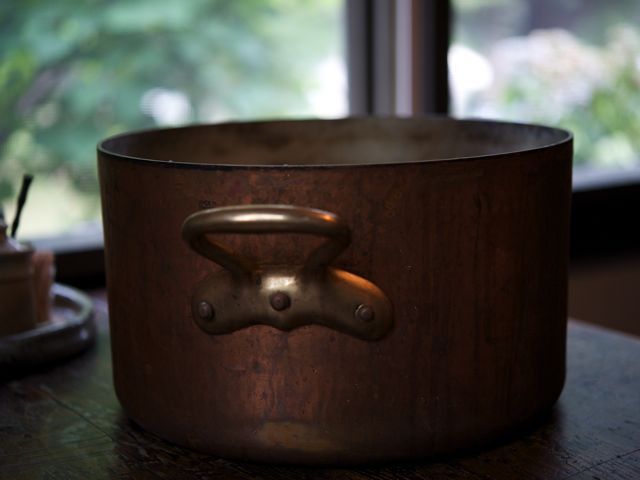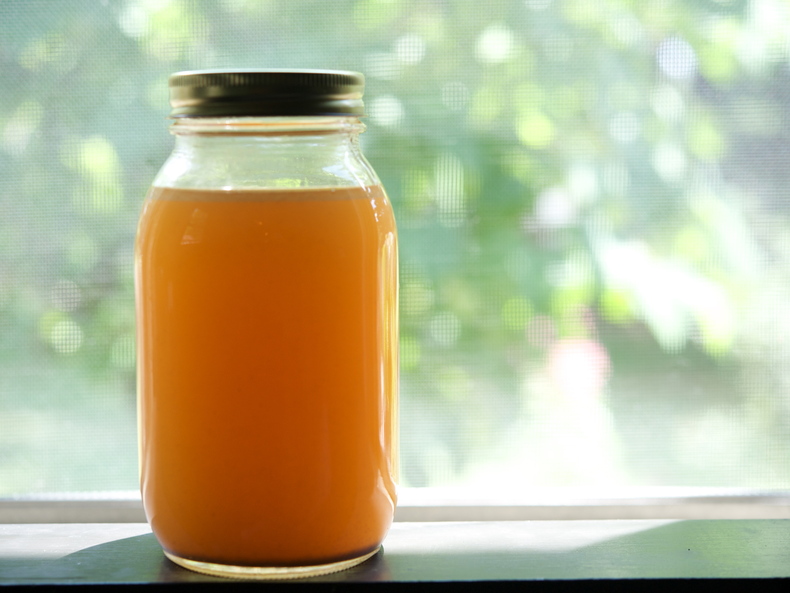7.18.10 Liquid Gold
Once you make chicken stock using this recipe, I promise you'll never want to go back to that stuff in the box, no matter how organic it is or how convenient it seems. You can make an enormous vat of this and freeze small containers or even ice cube trays full of it to use for months. If space is at a premium in your freezer, you can boil the stock down to a concentrated and syrupy demi-glace which can later be reconstituted into stock by adding water. I got this recipe from Nourishing Traditions and it's really quite similar to most chicken stock recipes you'll find, with one key exception: you cook it over very low heat for at least 6 and as many as 24 hours! Turns out this make a huge difference in the flavor, color and consistency of the stock. It's rich, golden, unctuous without being greasy and highly flavored. Of course it helps if you are using a whole chicken, or lots of good bony parts, including necks and feet.

goldfinger
These contain large amount of nutritionally valuable gelatin, which aids digestion and can help in the treatment of intestinal disorders. It also helps the body more fully utilize the proteins ingested. We're all familiar with the folk wisdom about "Jewish penicillin," but broth has actually been prescribed since Maimonides' time in the 12th century for colds and asthma. The bottom line, of course, is flavor, and it will convince you above all else. When you make your own stock, you will marvel at how this combination of a few meaty bones and some simple vegetables give rise to such bounty.

heavy duty
You will need a nice, large and heavy stockpot. I am in love with the copper one G gave me and, as you can see, I have let it acquire its own patina over time. You soak the cut-up chicken parts (I use wing tips that I bag and keep frozen whenever I make roasted wings; necks that I save whenever I roast a whole bird; sometimes saved carcasses; and feet—the best!) and the vegetables in water with a little vinegar for an hour, and bring it to a boil. The next step is very important: you skim off all the impurities that rise to the surface. It can be almost a cupful of icky scum. Then you reduce the heat, put the lid on and walk away for a good few hours. As many as 24! I never have to replenish the water because the temperature is so low, and the lid keeps the condensation inside the pot. During the last 10 minutes of this long cooking period, you immerse a bunch of parsley to add back in some minerals. Then cool the stock, strain and refrigerate it overnight so the fat rises to the top. (You can keep this in a jar in the fridge for weeks, using it to roast vegetables, fry potatoes or baste your next roast chicken.)

take stock
The resulting stock is thick with gelatin, a glorious yellow-orange color and packed with flavor. I freeze mine in pint or quart jars (leave a few inches of headspace as the stock expands during freezing), and even in ice cube trays. You can defrost these ahead of time if you're planning a soup or sauce, or simply remove the lid and place the jar in a saucepan with water that comes about halfway up, set over medium-low heat and simmer until liquified. It's better than money in the bank.
Chicken Stock
makes 3-4 quarts
adapted from Nourishing Traditions
Note: This recipe calls for no salt. It's generally best to salt it once you know how it's going to be used. If you salt it and then reduce it for a demi-glâce or a sauce, you may find it way too salty.
-
— 1 whole free-range chicken, or 2-3 pounds bony chicken parts, including necks, backs, wings and feet
-
— gizzards from 1 chicken, optional
-
— 4 quarts cold filtered water
-
— 2 tablespoons vinegar
-
— 1 large onion, skin on and coarsely chopped
-
— 3 celery ribs, coarsely chopped
-
— 1-2 leeks, white and light green part only, cleaned and coarsely chopped
-
— 2 carrots, coarsely chopped
-
— 1 bunch parsley
If you are using a whole chicken, cut off the wings and remove any gizzards and/or the neck from the cavity (these can all be used for the stock). Free-range chickens will produce much better results than a factory-farmed bird.
Cut chicken parts into several smaller pieces. Put chicken or pieces into a large stainless steel pot with the water, vinegar and vegetables (except the parsley). Let stand for 30 minutes-1 hour.
Bring to a boil, and remove all scum that rises to the top. Then reduce the heat to low, cover and simmer for 6-24 hours. The longer you cook the stock, the richer and more flavorful it will be.
About 10 minutes before finishing the stock, stir in the parsley. This imparts additional mineral ions to the stock. Turn the heat off, and allow to cool before removing chicken pieces with a slotted spoon. (Feed it to the cat!)
Strain the stock through a fine mesh into a large bowl, pot or jar and refrigerate, covered, until any fat rises to the top and congeals. (I usually leave it overnight.) Skim off this fat and reserve the stock in covered containers in your fridge or freezer. It will keep in your fridge for 3-4 days; if you want to keep it there longer, you need to boil it again. Otherwise, you can clarify the stock and it will keep refrigerated for quite a bit longer.
 Download Recipe
Download Recipe



 Download Recipe
Download Recipe







4 Comments